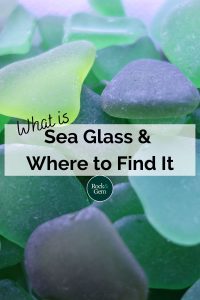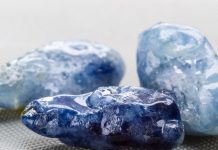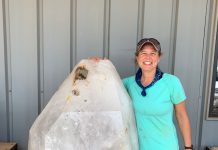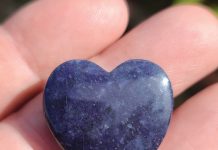
Sea glass hunting is like a treasure hunt. With pail in hand and the ocean waves softly undulating and dousing the sand, beachcombers, including fossil hunters in Florida, scour the shores for various curiosities like shark teeth and sea glass.
Seashells, fossils, driftwood, and other natural artifacts are commonly sought treasures, but some searchers seek broken bits of glass. No, they’re not on a clean-up-the-beach crusade. They’re hunting for sea glass. Created by both man and nature, sea glass is one of the ultimate examples of one person’s trash being another person’s treasure. When collecting, it’s important to remember the rules and find out is it legal to collect rocks and sea glass in your area.
What is Sea Glass?

Sea glass, also called beach glass, is broken pieces of old glass naturally recycled by an ocean or a large lake. Old bottles, jars, and other trash made of glass carelessly discarded into oceans decades ago wash back up on the shore after being tumbled through the sand and surf. What’s left behind are smooth edged glass pieces that are almost stone-like but with a unique frosted appearance.
The best beaches for finding sea glass are those that were formerly dumping grounds.
Residents of many coastal towns simply threw their household garbage into the ocean. There are areas where appliances, cars, and even entire buildings were pushed over cliffs to the shore below with the idea that the ocean would wash the trash away.
When this didn’t work out as planned, citizens in places like Fort Bragg, California, had to physically clear their beaches of massive amounts of debris. On the plus side, what was once a dump is now a popular destination for sea glass enthusiasts from around the world. Glass Beach in Fort Bragg is probably the most famous beach for finding sea glass worldwide. The town even boasts an entire museum dedicated to sea glass – the International Sea Glass Museum.

Courtesy Moira K. McGhee
A Dedicated Sea Glass Collector
Collecting sea glass has long been a passion of Susan Wilson, owner of Liliana Design in Scituate, Massachusetts (lilianadesigns.com). She has been collecting sea glass since childhood and later turned her hobby into a lucrative custom jewelry business.
“Walking the Cape Cod shores looking for that coveted blue piece was exciting and rewarding as a child. It still is! Here we have a case of trash to treasure,” said Wilson “When I found a piece of sea glass, I treated it much like a gemstone. My childhood imagination made me think of shipwrecks and lost bottles from treasure chests at sea. I was recently reminded that I would bring a pocket full of sea glass to school to share my treasures with my young friends. It’s not that different for me today. I still go out and hunt for sea glass when the tide is low and revel in each find, but today, I hunt with more knowledge of where the sea glass originated and this just adds to the intrigue.”
Sea Glass vs. Beach Glass
The primary difference between sea glass and beach glass is the body of water that created it. Sea glass comes from a saltwater environment, while beach glass comes from a freshwater environment. However, sea glass is found on a beach, so it wouldn’t technically be incorrect to also call it beach glass, even though diehard collectors may say you can’t use the terms interchangeably.
“To my knowledge, beach glass from lakes and rivers is slightly different from sea glass from the ocean,” Wilson said. “Sea glass has typically a more frosted appearance and little ‘C’ marks that are believed to be created by the action of saltwater, rock and sand. Beach glass seems to be more smooth and less frosted, probably because of the freshwater environment and less rugged shore from where they were made.”
Guessing Glass Age
Dating sea glass is a tricky undertaking.
However, long-time sea glass hunters have figured out various ways to guestimate the age of some sea glass pieces. Pitting and frosting are good indicators of age, as these traits require a certain amount of time in the water to materialize. Glass colors may help pinpoint the original age of a piece based on when specific colors became available or obsolete. Although there’s no conclusive way to pinpoint the exact age of glass fragments, it’s fun to try.
Wilson said the oldest pieces of sea glass she’s probably ever found were some of her gray pieces. These pieces had bubbles in them that indicated they were likely handblown and in the ocean for a long time.
“[These were] very frosted and round but also very thick and quite large, so I tended to keep them on a shelf,” she said. “It’s difficult to accurately date sea glass but I inherited a brass microscope from my parents who were scientists and I use that to help identify and date pieces. I find it fascinating and it satisfies the explorer in me.”

Courtesy Moira K. McGhee
Sea Glass Colors
Besides age, sea glass collectors continually look for rare glass colors. Certain colors, such as green, brown, and clear/white, are the most abundant colors because they were commonly used for bottles, jars, and other glass containers. Colors like red, orange, and yellow are much more scarce.
Wilson says that by many people’s accounts, “the rarest colors of sea glass are orange, turquoise and red. Manufacturers didn’t commonly use these colors for bottles or dishware. These colors were hard to create in glass, so they weren’t highly commercially made.”
Black, teal and gray come next and are from old bottles, most likely pre-1900s when it was common to add iron slag to the silica for the black color. Gray was likely from a piece of leaded glass tableware or gray bottles of times past and teal from the combination of cobalt, iron, and chromium.
According to Wilson, much less common are pink, aqua, cobalt, cornflower and deeper purple pieces. Blues are the most popular among collectors but aren’t so rare as they came from more common chlorine bottles and perfume bottles as well as dishware. “They’re still much less common than the green, seafoam (older coke bottles), white, and brown pieces, which are from beer, beverage and wine bottles mostly.”
Common sources for popular colors include:
• Sapphire Blue – apothecary bottles
• Jade Green – Depression-era tableware or ornamental lampshades
• Purple – art glass or apothecary bottles
• Orange – car turn signals and art glass
• Red – car taillights
“I’ve found at least a few pieces of most colors of sea glass,” said Wilson. “I spend a lot of time trying to research their origins and love the history and discovery.”
She says the one piece of sea glass she covets that continues to elude her is a jewelry-quality, frosted true orange piece of sea glass.
“[Orange] is considered the rarest sea glass find,” said Wilson. “This is usually from old art glass or limited dishware and bottles. These are tremendously rare. I have a few small pieces that aren’t as frosted as what I use for jewelry so, to find a jewelry-quality piece would be fantastic!”

Courtesy Susan Wilson
Creating New Treasures
Finding nice specimens of sea glass is only the beginning. Wilson and many other sea glass collectors have turned their love of sea glass into dazzling pieces of art and stunning jewelry pieces.
“I learned to silversmith when I was a teenager during summers on Cape Cod at the Artist Guild in Falmouth, Massachusetts,” she said. “It was there that I began to set unusual objects I found like wood and natural stone. It wasn’t until I had amassed a huge collection of sea glass in my adult years that I decided to get back into silver jewelry making.”
Wilson finds sea glass to be a natural fit for jewelry.
“I quickly discovered that sea glass was a natural match for setting in silver. The light reflects back from the silver through the sea glass when set with a silver backing and shines through the sea glass when drilled for pendants and bracelets providing a colorful glow. I also discovered I could use a lapidary technique with diamond drill bits to drill holes in sea glass.”
A Sea Glass Business
For Wilson, sea glass has become her full-time business.
“These fortuitous discoveries allowed me to leave my job in Boston and create my sea glass jewelry business. I soon discovered there were thousands of people out there that loved sea glass and were drawn to these elusive treasures set in silver and gold.”
Who knew bottles, jars and other trash made of glass left behind from indiscriminate dumping on ocean shores decades ago would become coveted items to beachcombers and collectors around the world? Low tide is generally the best time to search for sea glass on most beaches.
Looking for sea glass is like a treasure hunt. You never know what you’ll find. However, always confirm whether it’s legal to remove sea glass from the source with local authorities. Happy hunting!
Top Glass Beach DestinationsTalk to avid sea glass collectors or simply do a little online research and you’ll find beaches noted for being some of the best for hunting sea glass. Here are some top picks from around the world. Glass Beach, MacKerricher State Park Fort Bragg, California Seaham Hall Beach Seaham, England Simmons Island Beach Kenosha, Wisconsin Kauai Sea Glass Beach Kauai, Hawaii Glass Beach Port Townsend, Washington Summerland Beach Santa Barbara, California Sea Glass Beach Okinawa Island, Japan Grant Park Beach South Milwaukee, Wisconsin Mornington Back Beaches Melbourne, Australia Souris Beach Prince Edward Island, Canada Sea Glass Points of InterestThe International Sea Glass Museum www.internationalseaglassmuseum.com North American Sea Glass Association seaglassassociation.org |
This story about sea glass previously appeared in Rock & Gem magazine. Click here to subscribe. Story by Moira McGhee.















